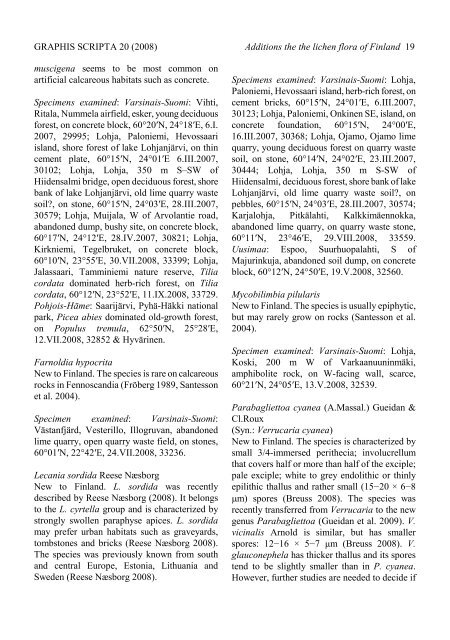Additions to the lichen flora of Finland. IV
Additions to the lichen flora of Finland. IV
Additions to the lichen flora of Finland. IV
You also want an ePaper? Increase the reach of your titles
YUMPU automatically turns print PDFs into web optimized ePapers that Google loves.
GRAPHIS SCRIPTA 20 (2008) <strong>Additions</strong> <strong>the</strong> <strong>the</strong> <strong>lichen</strong> <strong>flora</strong> <strong>of</strong> <strong>Finland</strong> 19<br />
muscigena seems <strong>to</strong> be most common on<br />
artificial calcareous habitats such as concrete.<br />
Specimens examined: Varsinais-Suomi: Vihti,<br />
Ritala, Nummela airfield, esker, young deciduous<br />
forest, on concrete block, 60°20′N, 24°18′E, 6.I.<br />
2007, 29995; Lohja, Paloniemi, Hevossaari<br />
island, shore forest <strong>of</strong> lake Lohjanjärvi, on thin<br />
cement plate, 60°15′N, 24°01′E 6.III.2007,<br />
30102; Lohja, Lohja, 350 m S–SW <strong>of</strong><br />
Hiidensalmi bridge, open deciduous forest, shore<br />
bank <strong>of</strong> lake Lohjanjärvi, old lime quarry waste<br />
soil?, on s<strong>to</strong>ne, 60°15′N, 24°03′E, 28.III.2007,<br />
30579; Lohja, Muijala, W <strong>of</strong> Arvolantie road,<br />
abandoned dump, bushy site, on concrete block,<br />
60°17′N, 24°12′E, 28.<strong>IV</strong>.2007, 30821; Lohja,<br />
Kirkniemi, Tegelbruket, on concrete block,<br />
60°10′N, 23°55′E, 30.VII.2008, 33399; Lohja,<br />
Jalassaari, Tamminiemi nature reserve, Tilia<br />
cordata dominated herb-rich forest, on Tilia<br />
cordata, 60°12′N, 23°52′E, 11.IX.2008, 33729.<br />
Pohjois-Häme: Saarijärvi, Pyhä-Häkki national<br />
park, Picea abies dominated old-growth forest,<br />
on Populus tremula, 62°50′N, 25°28′E,<br />
12.VII.2008, 32852 & Hyvärinen.<br />
Farnoldia hypocrita<br />
New <strong>to</strong> <strong>Finland</strong>. The species is rare on calcareous<br />
rocks in Fennoscandia (Fröberg 1989, Santesson<br />
et al. 2004).<br />
Specimen examined: Varsinais-Suomi:<br />
Västanfjärd, Vesterillo, Illogruvan, abandoned<br />
lime quarry, open quarry waste field, on s<strong>to</strong>nes,<br />
60°01′N, 22°42′E, 24.VII.2008, 33236.<br />
Lecania sordida Reese Næsborg<br />
New <strong>to</strong> <strong>Finland</strong>. L. sordida was recently<br />
described by Reese Næsborg (2008). It belongs<br />
<strong>to</strong> <strong>the</strong> L. cyrtella group and is characterized by<br />
strongly swollen paraphyse apices. L. sordida<br />
may prefer urban habitats such as graveyards,<br />
<strong>to</strong>mbs<strong>to</strong>nes and bricks (Reese Næsborg 2008).<br />
The species was previously known from south<br />
and central Europe, Es<strong>to</strong>nia, Lithuania and<br />
Sweden (Reese Næsborg 2008).<br />
Specimens examined: Varsinais-Suomi: Lohja,<br />
Paloniemi, Hevossaari island, herb-rich forest, on<br />
cement bricks, 60°15′N, 24°01′E, 6.III.2007,<br />
30123; Lohja, Paloniemi, Onkinen SE, island, on<br />
concrete foundation, 60°15′N, 24°00′E,<br />
16.III.2007, 30368; Lohja, Ojamo, Ojamo lime<br />
quarry, young deciduous forest on quarry waste<br />
soil, on s<strong>to</strong>ne, 60°14′N, 24°02′E, 23.III.2007,<br />
30444; Lohja, Lohja, 350 m S-SW <strong>of</strong><br />
Hiidensalmi, deciduous forest, shore bank <strong>of</strong> lake<br />
Lohjanjärvi, old lime quarry waste soil?, on<br />
pebbles, 60°15′N, 24°03′E, 28.III.2007, 30574;<br />
Karjalohja, Pitkälahti, Kalkkimäennokka,<br />
abandoned lime quarry, on quarry waste s<strong>to</strong>ne,<br />
60°11′N, 23°46′E, 29.VIII.2008, 33559.<br />
Uusimaa: Espoo, Suurhuopalahti, S <strong>of</strong><br />
Majurinkuja, abandoned soil dump, on concrete<br />
block, 60°12′N, 24°50′E, 19.V.2008, 32560.<br />
Mycobilimbia pilularis<br />
New <strong>to</strong> <strong>Finland</strong>. The species is usually epiphytic,<br />
but may rarely grow on rocks (Santesson et al.<br />
2004).<br />
Specimen examined: Varsinais-Suomi: Lohja,<br />
Koski, 200 m W <strong>of</strong> Varkaanuuninmäki,<br />
amphibolite rock, on W-facing wall, scarce,<br />
60°21′N, 24°05′E, 13.V.2008, 32539.<br />
Parabagliet<strong>to</strong>a cyanea (A.Massal.) Gueidan &<br />
Cl.Roux<br />
(Syn.: Verrucaria cyanea)<br />
New <strong>to</strong> <strong>Finland</strong>. The species is characterized by<br />
small 3/4-immersed peri<strong>the</strong>cia; involucrellum<br />
that covers half or more than half <strong>of</strong> <strong>the</strong> exciple;<br />
pale exciple; white <strong>to</strong> grey endolithic or thinly<br />
epilithic thallus and ra<strong>the</strong>r small (15−20 × 6−8<br />
µm) spores (Breuss 2008). The species was<br />
recently transferred from Verrucaria <strong>to</strong> <strong>the</strong> new<br />
genus Parabagliet<strong>to</strong>a (Gueidan et al. 2009). V.<br />
vicinalis Arnold is similar, but has smaller<br />
spores: 12−16 × 5−7 µm (Breuss 2008). V.<br />
glauconephela has thicker thallus and its spores<br />
tend <strong>to</strong> be slightly smaller than in P. cyanea.<br />
However, fur<strong>the</strong>r studies are needed <strong>to</strong> decide if

















